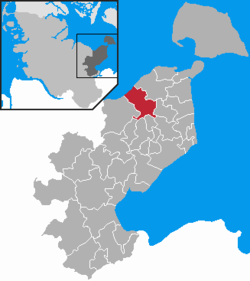Oldenburg in Holstein
Oldenburg in Holstein (German: [ˈɔldn̩ˌbʊʁk ɪn ˈhɔlˌʃtaɪ̯n] (![]()
Oldenburg in Holstein | |
|---|---|
 Town hall | |
 Coat of arms | |
Location of Oldenburg in Holstein within Ostholstein district  | |
 Oldenburg in Holstein  Oldenburg in Holstein | |
| Coordinates: 54°18′0″N 10°53′0″E | |
| Country | Germany |
| State | Schleswig-Holstein |
| District | Ostholstein |
| Government | |
| • Mayor | Martin Voigt |
| Area | |
| • Total | 39.67 km2 (15.32 sq mi) |
| Elevation | 8 m (26 ft) |
| Population (2018-12-31)[1] | |
| • Total | 9,833 |
| • Density | 250/km2 (640/sq mi) |
| Time zone | CET/CEST (UTC+1/+2) |
| Postal codes | 23758 |
| Dialling codes | 04361 |
| Vehicle registration | OH |
| Website | www.oldenburg-holstein.de |
Oldenburg was the chief town of the Wagrians, one of the Slavic peoples that migrated as far west as the river Elbe in or after the 6th century (see Völkerwanderung), also known as Wends and Obotrites. They arrived about A.D. 700 and the Pomeranian/Kashubian (Slavic) name was Starigard or Stargard, meaning "Old Settlement", "Old Castle", "Old City/Town"; the German name Oldenburg is of Low German origin and carries the same meaning. The Obotrites were allies of Charlemagne. Emperor Otto I established the bishopric of Oldenburg under Adaldag, archbishop of Hamburg.
To the Northern Germanic Vikings, the city was known as Brandehuse, i.e. "the burned houses", indicating the bellicose times.
For centuries, Starigard/Oldenburg remained the Slavic competitor of Hedeby on the Baltic trade, until the counts Adolph I and Adolph II of Schauenburg and Holstein, supported by Henry the Lion, finally defeated the Wends during the first half of the 12th century.
The modern town has a partnership with Bergen auf Rügen in Mecklenburg-Vorpommern.
See also
References
- "Statistikamt Nord – Bevölkerung der Gemeinden in Schleswig-Holstein 4. Quartal 2018 (XLS-file)". Statistisches Amt für Hamburg und Schleswig-Holstein (in German).
External links
![]()